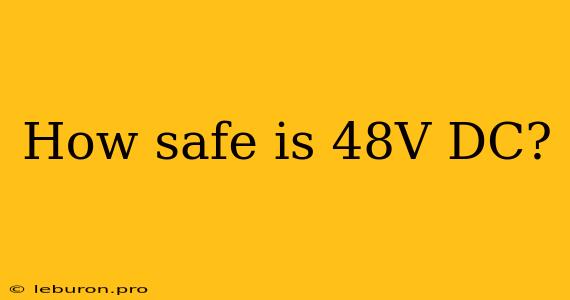The Safety of 48V DC Systems: A Comprehensive Look
The increasing adoption of 48V DC systems in various applications, from automotive to data centers, raises a crucial question: How safe is 48V DC? While lower than traditional AC power lines, 48V DC can still pose safety risks if not handled properly. This article will delve into the safety considerations surrounding 48V DC, examining its potential dangers and the measures needed to mitigate them.
Understanding the Risks of 48V DC
While 48V DC is considered "low voltage" compared to the 120V or 240V AC found in homes and offices, it can still cause harm under certain circumstances. The primary risks associated with 48V DC systems include:
1. Electric Shock: Even at 48V, electric shock can be hazardous, especially if the current is high. The human body's resistance to electricity varies, but a current as low as 30 mA can cause muscle contractions and difficulty breathing.
2. Arc Flash: 48V DC systems, while less likely to cause arc flash than higher voltage AC systems, can still produce a dangerous arc flash under specific conditions, such as a short circuit. Arc flash can result in severe burns and other injuries.
3. Fire Hazards: High currents in 48V DC systems can generate heat, potentially leading to fires if proper wiring and safety precautions are not in place.
Safety Measures for 48V DC Systems
To mitigate the risks associated with 48V DC systems, numerous safety measures must be implemented during design, installation, and operation. These measures include:
1. Low-Voltage Protection Devices:
- Fuses: Fuses are essential components in any electrical system, including 48V DC systems. They act as safety devices that break the circuit when excessive current flows, preventing overheating and potential fires.
- Circuit Breakers: Circuit breakers perform a similar function to fuses but are designed to be resettable. They can be used to isolate faulty sections of a 48V DC system quickly.
- Residual Current Devices (RCDs): Also known as Ground Fault Circuit Interrupters (GFCIs), these devices are designed to detect and interrupt electric current leakage to ground, offering additional protection against electric shock.
2. Proper Wiring and Insulation:
- Cable Selection: Using insulated cables with appropriate ampacity (current-carrying capacity) is vital for safe operation of 48V DC systems.
- Insulation Integrity: Regularly inspecting insulation for damage or wear is essential. Damaged insulation can expose bare conductors, increasing the risk of electric shock.
- Grounding: A robust grounding system is crucial to ensure that any fault currents are safely diverted to the ground, minimizing the risk of electric shock.
3. Safety Training and Procedures:
- Operator Training: All personnel working with 48V DC systems must undergo comprehensive training on the potential risks and appropriate safety practices.
- Lockout/Tagout Procedures: These procedures ensure that electrical equipment is properly isolated and safe before any maintenance or repair work is performed.
- Personal Protective Equipment (PPE): Appropriate PPE, such as insulated gloves, safety shoes, and eye protection, should always be worn when working on or near 48V DC systems.
Safety Comparisons with Higher Voltage Systems
It is important to understand that while 48V DC is safer than higher voltage systems like 120V or 240V AC, it still requires careful consideration of safety measures. The lower voltage reduces the risk of severe electric shock but does not eliminate it.
48V DC Safety Standards and Regulations
Several safety standards and regulations govern the design, installation, and operation of 48V DC systems, ensuring a high level of safety for individuals and the environment. These standards vary depending on the specific application and location.
Conclusion
48V DC systems can be safe if proper design, installation, and operating practices are followed. Implementing low-voltage protection devices, proper wiring and insulation, and thorough safety training are essential to mitigate the risks associated with these systems. By adhering to safety standards and regulations, we can harness the benefits of 48V DC technology while ensuring a safe and reliable operation.
